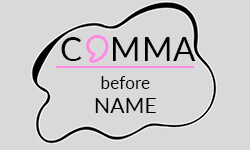
Many students struggle with proper comma usage in academic writing, particularly when it comes to commas before names. This confusion stems from a lack of knowledge of the specific rules and exceptions governing the use of commas. To help clarify this issue, we have put together an article that provides examples and outlines the exceptions to these rules and helps you understand them.
When to place a comma before a name
Generally, you place a comma before a name if it is part of a non-essential clause or a list containing three or more items. No comma is being placed if you’re not directly addressing a person.
Comma
Non-essential clause
In lists
No comma
No direct address
Comma rules may vary depending on style guides, and complex sentences may have exceptions for placement. Consider the readability without commas.
Comma before a name
When you insert the name in a sentence or the name as part of a non-essential clause, a comma is placed before the name. Additionally, you place a comma before the last name in a list containing three or more items. Below, we illustrate both cases with examples.
Non-essential clause
Commas are used before a name in a parenthetical clause to set off the clause from the rest of the sentence. When the information being named does not change the original meaning of the sentence, it is non-essential. The comma before and after the name helps to clearly indicate the boundaries of the parenthetical clause and aids in readability and comprehension. It tells the reader that the information within the clause is extra or supplementary to the main message of the sentence.
In Lists
A comma is used before and possibly after a name in a list of three or more items to separate the items and provide clarity in writing. The comma before the last item is known as the Oxford comma or serial comma. It helps avoid ambiguity and ensures that each item in the list is distinct. Here are three example sentences to illustrate its usage.
No comma before a name
You do not put a comma before a name when you’re not directly addressing a specific person. We show why and how this looks below with the help of example sentences.
No direct address
A comma is not placed before a name when you’re not addressing a specific person directly because the use of a comma in such cases would be grammatically incorrect. If you’re mentioning a name in a sentence but not directly addressing or referring to that person, there’s no need for a comma. In such cases, the name is simply part of the sentence’s structure, and using a comma would be unnecessary and could disrupt the flow and clarity of the sentence.
Test yourself!
Practice sheet
Clear ten sentences by correctly using commas before a name. Check whether you grasped the concept of placing commas before names or not by clicking on the second tab named “answers”.
- Our IT manager Tom will oversee the software upgrade.
- The managing director of the company Maria will address the employees at the meeting.
- My sister Sarah will visit us next weekend.
- A talented musician David will perform at the event.
- James will lead the sales team during the conference.
- John, Olivia and Suzy have confirmed the venue details.
- Please pass the message to our marketing director Maxime.
- Janet is responsible for the project’s financial analysis.
- Brian is an expert in web design and will create our website.
- The report prepared by our head of research Mark is quite informative.
- Our IT manager, Tom, will oversee the software upgrade. (Comma)
- The managing director of the company, Maria, will address the employees at the meeting. (Comma)
- My sister Sarah will visit us next weekend. (No comma)
- A talented musician, David, will perform at the event. (Comma)
- James will lead the sales team during the conference. (No comma)
- John, Olivia, and Suzy have confirmed the venue details. (Comma)
- Please pass the message to our marketing director, Maxime. (Comma)
- Janet is responsible for the project’s financial analysis. (No comma)
- Brian is an expert in web design and will create our website. (No comma)
- The report prepared by our head of research, Mark, is quite informative. (Comma)
- ✓ 3D live preview of your individual configuration
- ✓ Free express delivery for every single purchase
- ✓ Top-notch bindings with customised embossing

FAQs
A comma is typically placed before a name in the following cases:
- When the name is in a parenthetical (non-essential) clause.
- In lists of three or more items, including the final item before “and”
In all other cases, a comma is not used before a name.
A comma is typically not needed after a name, except in specific cases like when directly addressing someone or when the name is followed by a parenthetical (non-essential) clause.
Yes, there is typically a comma after “Hey John” when directly addressing someone. It separates the address or greeting (“Hey”) from the person’s name (“John”).
Example
“Hey, John, how’s it going?”
However, it’s become quite popular to leave the comma out. We recommend you using a comma before the name in formal writing.
In most cases, you should not put a comma between the first and middle name when writing someone’s full name. Instead, you should use a space to separate the first name from the middle name.
Example
- John David Smith
A comma is not typically used between the first and last name when writing someone’s full name in standard practice. Names are typically written with a space between the first and last name, not a comma.
Examples
- John Smith
- Mary Johnson
